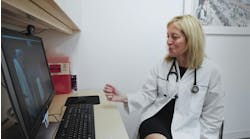When the leaders of ThedaCare—an eight-hospital, 40-clinic integrated health system based in the eastern Wisconsin cities of Appleton and Neenah—set out to transform their organization into a proactive partner in health, they knew this vision would require them to make some significant changes. ThedaCare, which serves Northeast and Central Wisconsin with eight hospitals and more than 180 points of care, confronted the same challenges facing providers everywhere: higher operational costs amid flat reimbursement; disruption from the shift to value-based care and population health; and vast amounts of data newly available from apps, wearables and devices.
Further complicating things, powerful new retail competitors like CVS, Walmart and Amazon were flexing their health care muscles. And patients increasingly expected the health system–like all health care providers–to step up to provide a digital experience rivaling that of other industries like banking, travel and shopping.
Through ThedaCare’s dedication to putting patients first and understanding each person’s individual needs, the system is focused on taking proactive approaches to care. They are committed to investing and seeking out partnerships that advance their vision, in this case by helping provide a holistic lens for each patient to understand their unique health care experience.
ThedaCare is leading the industry-wide shift to digitally-informed, value-based care, exchanging fee-for-service reimbursement for risk-based payment and leveraging digital health to support the shift. A component of this transformation is ThedaCare’s wellness program, called Better U, which is designed to incentivize employees to improve their overall health and well-being. The health system’s nearly 7,000 employees are invited to select ThedaCare’s own full-risk medical insurance and enroll in the program.
To succeed with Better U, ThedaCare established a dedicated team focused on containing employee total cost of care. The team uses various communications to encourage employees in the program to improve their health while also lowering costs for the health plan. To help support that effort, ThedaCare’s leaders knew they would need to capture a complete view of each member’s health. Accessing that view meant making sense of a patchwork of fragmented information held by multiple information systems, outside providers, payors, and the employees themselves. ThedaCare had to find a way to harness that sea of data and make it actionable for employees in an effort to affect the behavioral choices that influence 80 percent of a person’s health.
As part of their larger plans to reinvent health care, in early 2020 ThedaCare rolled out to its employees, patients and the community at large the nation’s first digital “front end” to health care, from b.well Connected Health. Dubbed “Ripple by ThedaCare,” the app and digital platform supports both patients and employees in the Better U program by integrating and analyzing data from virtually any source and enabling users to take action to improve their health while simultaneously lowering costs for themselves and the health system.
To accomplish this, Ripple by ThedaCare leverages the HL7® FHIR® (Fast Healthcare Interoperability Resources) standard and application programming interfaces (APIs) to consolidate a 360-degree view of real-time health data. Data are pulled into the app from ThedaCare’s Epic electronic health record as well as pharmacies, Medicare, the Veterans Administration, third-party apps and devices, and any FHIR-enabled health plan or provider portal. Ripple by ThedaCare then uses this rich set of data to provide personalized guidance to next-best actions.
The connected health platform behind Ripple by ThedaCare drives all of the Better U program’s analytics, measurement and engagement. All employees, especially those with chronic conditions, are encouraged to download the app, enroll in the Better U program, and provide permission-based access to their health information.
To ensure the app is personalized for each team member, analytics built into the platform apply risk stratification to identify those whose health conditions are rising-risk or high-risk. The platform then provides personalized health recommendations based on each team member’s condition and risk level. Further adjustments are made based on their performance in the program – measuring, for instance, whether they completed an annual physical or (for people with diabetes) an annual eye exam. To incentivize users to adhere to their care plans and take healthful preventative action, the platform uses behavioral economics and game theory. Users can earn rewards of up to $200 for meeting goals such as completing annual wellness visits including lab work, or increasing their physical activity week over week. Participating employees who meet requirements also will pay no co-pays for primary care visits during 2023.
A year and a half after launch, the Better U program has generated high levels of adoption and engagement, as well as significant financial and health outcomes. Of the more than 4,200 employees and their spouses who participate in the ThedaCare health plan, and who registered as users of ThedaCare by Ripple since 2020, over 3,500, or 84 percent, participated in the Better U program in 2022.
With adoption rates high, ThedaCare used the app to drive engagement with Better U’s goals. One goal was to increase the number of employees seeing their primary care physicians annually, which helps to close gaps in care and create the best health outcomes. Through behavior-change messaging, users were encouraged to choose an in-network provider in-app and click to schedule an annual wellness physical.
Among the highlights of Ripple at ThedaCare and Better U:
• The connected health platform behind Ripple by ThedaCare drives all of the Better U program’s analytics, measurement and engagement.
• All employees, especially those with chronic conditions, are encouraged to download the app, enroll in the Better U program, and provide permission-based access to their health information.
• To ensure the app is personalized for each team member, analytics built into the platform apply risk stratification to identify those whose health conditions are rising-risk or high-risk.
• The platform then provides personalized health recommendations based on each team member’s condition and risk level.
• Further adjustments are made based on their performance in the program – measuring, for instance, whether they completed an annual physical or (for people with diabetes) an annual eye exam.
• To incentivize users to adhere to their care plans and take healthful preventative action, the platform uses behavioral economics and game theory.
• Users can earn rewards of up to $200 for meeting goals such as completing annual wellness visits including lab work, or increasing their physical activity week over week.
• Participating employees who meet requirements also will pay no co-pays for primary care visits during 2023.
The result: In 2022, 70 percent of employees on the app completed an annual physical, a 23-percent increase over 2021 and more than double the rate for employees not on the app. Among employees and spouses identified as high risk, 82 percent completed their annual physicals.
Another Better U goal was to encourage use of in-network providers to keep care within ThedaCare, creating a more connected care journey and lowering health plan costs. That effort, too, proved successful thanks to Ripple by ThedaCare. In 2022, there was also a 12% increase in the use of in-network primary care providers among Better U participants, and a corresponding 17-percent decrease in out-of-network utilization. Since in-network PCPs cost 19 percent less on average than out-of-network PCPs, ThedaCare recognized $244,000 in savings from that change alone.
More savings were achieved by successfully encouraging Better U participants to choose the most appropriate site of care. Following care recommendations provided by the app and other internal communications, employees increased their use of in-app telemedicine, which led to a 49% decline in non-emergent Emergency Department visits, and a corresponding 128% increase in telemedicine visits and visits to in-network urgent care clinics. By converting employees from the high-cost ED to lower cost clinics, ThedaCare netted $274,000 in savings, while also ensuring those resources are available for high-acuity health needs.
Taken together, the combination of care-level conversion and higher in-network utilization drove $518,000 in cost savings for ThedaCare during 2022.
Among many other improvements supported by the Better U program in 2022, three key changes in chronic health measures stand out. Like the general population in Wisconsin, where 22% of adults have hypertension and 8.5% have diabetes, ThedaCare employees and spouses on the ThedaCare health plan suffer from high levels of hypertension (26%) and diabetes (9%). Employees with these conditions are encouraged to enroll in Better U, where their participation drove significant improvements in condition management.
Among employees with hypertension (9.5 percent of Better U participants), 85% improved their systolic blood pressure measures in 2022, compared with 68 percent of all Better U participants. And among employees with diabetes, who represent 54 percent of the program’s participants, engagement with Ripple by ThedaCare during the year drove improvements of 22 percent in LDL levels and 37 percent in hemoglobin A1C levels.
Going forward, ThedaCare is focused on continuing to use Ripple by ThedaCare as a primary digital means of engaging employees in health improvement. At the same time, ThedaCare continues to encourage more patients in the community to use the app. New areas of focus in 2023 include using the app to help reduce the percentage of overall pharmacy costs attributed to specialty medications, polypharmacy, or individuals who use 10 or more medications. Both through the use of the app and other means, ThedaCare pharmacy programs will also focus on reducing unnecessary overuse of costly chronic condition-specific medicines.
Recently, Healthcare Innovation Editor-in-Chief Mark Hagland spoke with Mark Cockley, M.D., ThedaCare’s chief clinical officer and a practicing internal medicine and pediatrics physician, about the organization’s transformative initiative. Below are excerpts from that interview.
From your perspective, what has been the core driving factor in this initiative?
What we’re looking at doing is becoming a population health organization. Everyone wants to improve the quality of care, but there’s dire urgency to change the way we do healthcare. The escalating costs are unsustainable. And how can we leverage technology? I’ve been on an electronic health record for 20 years. And every other industry has done innovation and automation to get things done. We have an electronic health record; but how do we unify it wherever we go? We basically electronically copied what we were doing with paper charts. And we’ve partnered with b.well, using that app, that aggregates the data into a common platform where I can look at medications, labs, appointments, etc. And as much as you think it’s electronic, the vendors don’t necessarily like making their information easy to access.
What are some of the interoperability challenges and opportunities involved?
One opportunity is simply connecting into the database. How do we connect the app into our internal EHR? You have to deal with the vendor so that data can go in and come out. It would be great for a patient to quickly see their data. And the doctors need to be assured the information is accurate. And claims data. You can have a great repository of data, but if it’s not connected in, it’s not as valuable.
And the interoperability challenges?
Some of it has involved working with the vendors; some has been verifying that the technical connections are appropriate. But it’s to make that one location for patients to go to, versus multiple sites and apps.
So many health system leaders create a basic, functional patient portal and stop there, without creating true patient engagement around it? How are you and your colleagues at ThedaCare changing that equation?
You’re spot on. The information accessible to patients has to be usable, accurate, easy to use. What’s why we created our Better U. For our 7,000 employees, we said, we want to help you stay healthy. So you log in and create a Ripple account, and then you get a discount in your health insurance. 84 percent of employees have logged on and participated; significant engagement. And we’ve been working on closing care gaps. Engaging people around hypertension and blood sugar control and reduced utilization of the ED.
As chief clinical officer, what have been the biggest challenges you’ve faced?
From a clinical standpoint, the biggest initial challenge was simply getting a new process in place. I need to see someone to order mammograms or colonoscopies. Why don’t we make it easy for people? So they can just go into their app and arrange appointments? Emulate what others are doing in other industries. If I want to fly somewhere, it takes two minutes to book a flight. Why should it be more difficult in HC? Some of it might be the fear factor of docs and others over changing to more of a consumer focus.
Have you and your colleagues moved to address consumerism?
We are working as fast as we can to do that. Do we need to go at a quicker pace? Yes. Some of it involves changing workflows for care teams. And the concerns of physicians around releasing lab results to patients. So put more resources in there, too, and give the patients the right information and resources.
And you’ve had to educate physicians and engage them around what you’re doing, right?
Yes. And we’re still recommending things patients should be doing. Ripple might remind a patient, you’re still due for your screenings. About 5 percent of our population spends about 50 percent of the healthcare dollars. We can now identify the patients whom we need to assist in navigation.
Has the physician culture evolving forward well in your organization?
I think we’re going in the right direction, and it’s really going in the right direction. And initially, it was, that data couldn’t be right. But now they’re accepting that the data is accurate. And it’s not about being good or bad, but how we can help the physicians to help patients. Rapid-cycle adjustments. Physicians: we’re getting some good momentum, clearing away the suspicion. And some are reaching out for help to get better.
What has your organization’s journey been like around data analytics?
We’re doing well. Getting that right platform to put it on, and alignment, is good. We have some very good clinical leaders who have stepped into the analytics. You can overwhelm yourself with data, but asking for the right inputs can help you perform better. Paralysis by analysis. Let’s decide where we want to go, start collecting the data and adjust as necessary. And you start off with the higher demand and bigger opportunities and lower-hanging fruit. And with our employes, we can aggregate the data. Looking at high cost of care, etc.
And the expansion of Ripple beyond employees?
We’re expanding it out right away. Meanwhile, if they’re in our EHR, we can give them more access.
What will the next few years be like on this journey?
It will involve utilizing the technology that we have. It’s always tempting to add on that next shiny object. But we’re focusing on making sur we’re connecting things as needed. And in the app, I can even add family members. For example, my wife does a lot to take care of her parents. To be able to include them, that’s another set of tasks. But that will be beneficial and will be revolutionary for achieving the right care, for managing chronic diseases, for moving into addressing the social determinants of health. That’s another aspect we’re doing, embedding that data into our EHR. So you could do outreaches for SDOH screenings on a periodic basis.



